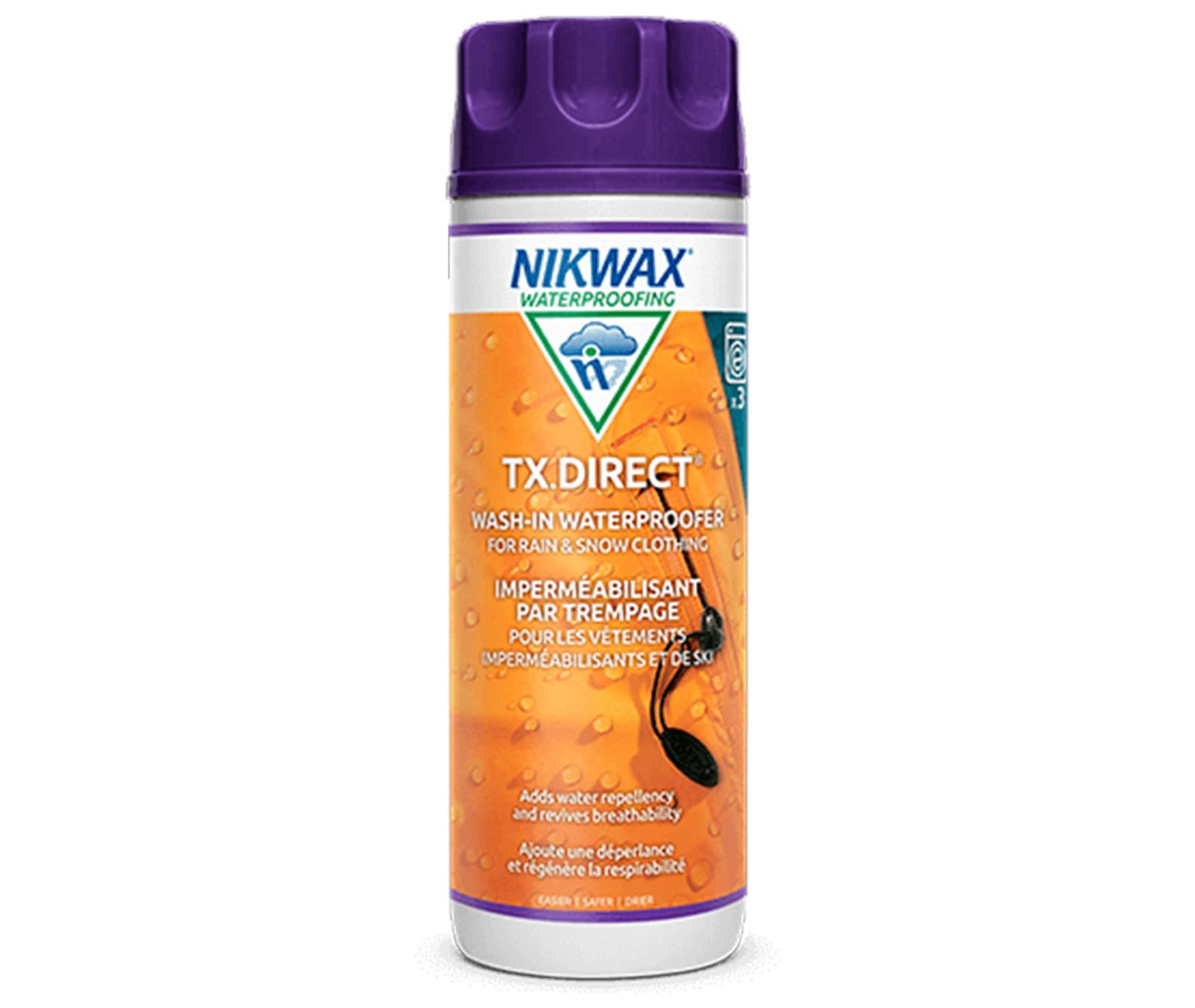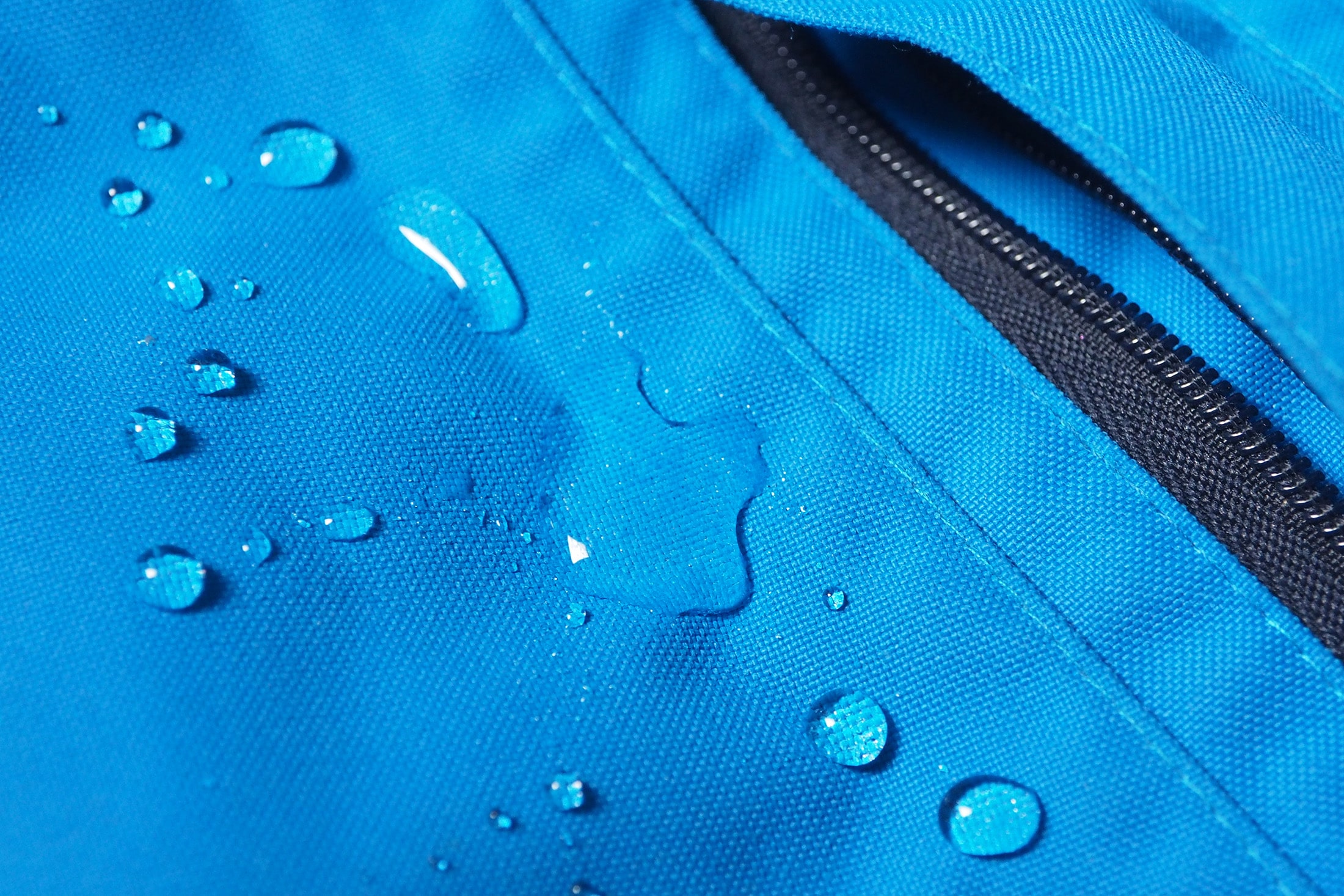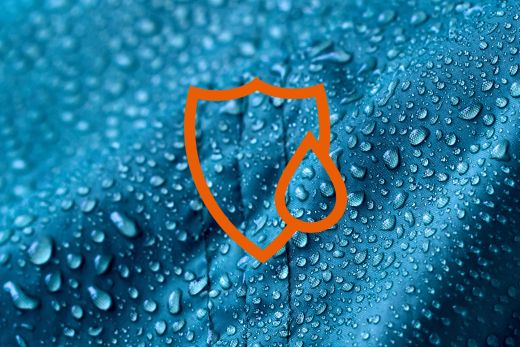If you’ve ever found yourself trying to choose between two waterproof jackets and wondering what was meant by ‘tricot’, ‘DWR, or ‘water-resistant’, this article is for you. In this gear guide, I’m going to go into the technology used in waterproof fabrics and the things you might want to consider when choosing your next piece of rainwear. Just know that it’s going to get a little nerdy as this is the most technical article in a whole series on waterproof garments. If you are looking for something more general, like how to choose a rain jacket or an article explaining the differences between a soft shell and a hard shell, I have articles on those too.
Waterproof vs water-resistant
To ensure proper protection in the conditions you expect to face, it’s important to know the difference between the three levels of water protection afforded by fabrics. To be clear, the industry has yet to develop a standardized system for rating the water resistance of fabrics, and what I have done here is use designations where there is the most consensus among brands. Thankfully, many manufacturers have performed a more or less standardized test, which makes it possible to make comparisons. In a hydrostatic head test, an open-ended cylinder is placed on top of a piece of fabric and slowly filled with water. Results are measured in how much water the material can be exposed to (in milimeters) before it begins to seep.
Water-resistant (0 to 1,500 mm)
‘Water-resistant’ means that a fabric is tightly woven or manufactured in such a way that it resists penetration by moisture. But that doesn’t mean much. A garment made from water-resistant fabric won’t keep you dry in much more than a misty morning fog or a little drizzle. This is the lowest level of protection against moisture. Water-resistant fabrics perform very poorly in hydrostatic head tests and usually aren’t even tested.
Water-repellent (1,500 to 5,000 mm)
Water-repellent fabrics have one up on water-resistant fabrics in that they have a durable water repellent (DWR) coating which causes water to bead and roll off a jacket instead of soaking through it. This slows the speed at which a jacket becomes saturated in sustained rain. Because they don’t have waterproof membranes, water-repellent fabrics are only good for keeping you dry in light rain and are not sufficient for rainwear.
Waterproof (over 5,000 mm)
A waterproof layer will protect you in moderately heavy to very heavy rain depending on its rating. In very wet conditions, a fabric rated to 10, 000 mm will keep you drier than one rated to 5,000 mm, but above 20, 000 mm there is little notable difference in performance. Garments deemed waterproof typically have a DWR-treated face fabric and a waterproof-breathable membrane. Beyond this, they also need to have sealed seams (taped or heat welded) to ensure that water doesn’t get through the seams.
How do waterproof breathable fabrics work?
The fabrics used in technical rain wear typically have at least two layers: a waterproof breathable membrane and a permeable outer face fabric that protects the membrane.
A membranes acts as a barrier to water
At the core of every waterproof breathable fabric, there is a membrane which acts as a barrier to liquid water. These membranes come in two types: the first is porous and allows for air to pass through it while preventing the transmission of water droplets. The second, less breathable type of membrane is non-porous and allows for only water vapor to pass through it. Despite their functional differences, both types of membrane have to remain clean and unclogged if they are to ‘breathe’ at all.
The DWR-treated outer fabric helps the membrane to breathe
A waterproof membrane will usually stop breathing if the face fabric ‘wets out’ and becomes saturated in water. With nowhere to go, the water vapor in your perspiration then accumulates on the inside of your jacket, making you cold and sweaty. To prevent this, manufacturers treat their face fabrics with a hydrophobic Durable Waterproof Repellant (DWR), which causes water to bead up and roll off fabric instead of permeating it. The more effective the DWR, the better a fabric will breathe and keep you dry.
PFAS-free membranes and DWR
Up until recently, both the membranes and DWR found in waterproof fabrics relied on per- and polyfluorinated alkyl substances (PFAS) to repel water and make fabrics breathable. The problem with PFAS is that they do not break down over time and are harmful to the environment and people who can ingest them. To solve this problem, gear manufacturers have invested heavily in the development of PFAS-free membranes and DWR.
Nikwax was the first major brand to launch a range of PFAS-free products with TX.Direct Wash-in and Direct.Dry (factory-applied DWR), but many others have since followed their example. Gear Aid now make their own PFAS-free DWR called Revivex, and at least a few fabric manufacturers, like Gore-Tex, have developed their own PFAS-free DWR. But it’s not just DWR that has traditionally contained PFAS. Most membranes are still made using PFAS, although the fluorine-free trend is gaining momentum here too with eVent, Gore-Tex, and several clothing manufacturers developing PFAS-free membranes.
What are the downsides to PFAS-free fabrics and DWR?
As can only be expected, there are some downsides to PFAS-free fabrics and DWR. The most significant of these is that PFAS-free garments have to be washed and reapplied with DWR more regularly. If in the past, you washed and reapplied DWR to your rain wear only once a season, you might find that you need to reapply DWR two or three times a season. But for most consumers, that will be a small price to pay for owning a more sustainable product. Reapplying DWR is also pretty easy as I explain in my guide on how to apply DWR.
Which brands make garments that are PFAS-free?
PFC-free DWR and face fabrics are now the norm, but only a few brands are using PFC-free membranes in all their garments. Patagonia and Fjällräven are two brands that stand out in having already achieved this. Other brands, like Rab and Outdoor Research, have committed to being 100% by the end of 2025 and have already made progress in removing PFAS from most of their products. There are also those brands that will only start using PFAS-free because the law demands it.
| Brands that are completely PFAS-free | Brands that are close to PFAS-free |
| Patagonia | Rab |
| Fjällräven | Outdoor Research |
| Houdini | Arc’teryx |
| Jack Wolfskin |

2L, 2.5L and 3L fabrics
Most waterproof fabrics are constructed in one of three ways: with 2 layers, 2.5 layers, or 3 layers. Each has its own pros and cons, and differs from the others in terms of breathabiity, durability, weight and bulk.
2L fabrics
Traditionally, 2-layer shells have had a face fabric bonded to a waterproof-breathable membrane with a loose (typically mesh) protective liner hanging inside them. Although more affordable, these mesh-lined 2L garments are generally heavier, bulkier, and less comfortable than 2.5L and 3L equivalents. However there are now also a few innovative 2L fabrics which use a textured membrane that increases abrasion resistance and makes an additional protective layer unnecessary. Garments made with these fabrics don’t need a mesh lining, meaning that they can be made lighter and less bulky.
2.5L fabrics
Like 2L and 3L fabrics, 2.5L fabrics also have DWR-treated face fabric and a waterproof-breathable membrane. But instead of having a separate mesh lining like most 2L fabrics or an inner layer bonded to the membrane like 3L fabrics, 2.5L fabrics have a thin protective coating (the 0.5 layer) painted onto the inside of the membrane. In the past, these coatings weren’t as good at absorbing and transmitting perspiration as a tricot lining, and many 2.5L shells left wearers feeling a bit clammy when they were worn next to skin. But recent developments in 2.5L fabric construction have helped improve the clammy factor, and some 2.5L shells are now almost as comfortable as 3L equivalents.
3L fabrics
In 3-layer fabrics the waterproof-breathable membrane is sandwiched between the face fabric and a protective inner lining. Again, the main purpose of this last layer is to prevent sweat and oils from clogging the microscopic holes in the membrane – something that would hinder breathability and make the wearer clammy with perspiration. It is this ability of the lining to prevent a membrane from becoming fouled that gives 3-layer fabrics an advantage over comparable 2.5 layer fabrics. The disadvantage of 3L fabrics is that they are slightly heavier than 2.5L fabrics (2L garments have a separate inner lining and can actually be heavier). As with 2L and 2.5L fabrics, the degree to which a 3L fabric is breathable depends on the type of waterproof-breathable membrane.

Waterproof-breathable membranes
Making a garment waterproof isn’t difficult, but making it waterproof and breathable is. To overcome this challenge, gear manufacturers have all turned to the same solution, a waterproof-breathable membrane. The original ePTFE membrane was produced by Gore-Tex, a brand that dominated the market for decades. 60 years on, there are now four different types of waterproof-breathable membranes and a dozen companies making them. This is what you need to know about the pros and cons of each.
Air-permeable membranes
Because they are porous, air-permeable membranes allow for the transmission of air and water vapor molecules, making them significantly more breathable than vapor-permeable membranes, which don’t allow air to pass through them. Given how important breathability is for preventing the build up of sweat during exercise, this type of membrane is often a better choice for physically intense activities.
ePTFE
Expanded polytetrafluoroethylene, or ePTFE for short, is the material that was first used in waterproof-breathable membranes. Because it doesn’t need to be as thick as polyurethane, it can be made thinner and more breathable than polyurethane film equivalents. The downside to ePTFE membranes is that they can become fouled more easily (impairing breathability) if exposed to oil and dirt and need to be washed regularly to ensure breathability and longevity. Products include Gore-Tex Pro and eVent, the two most expensive outdoor fabric brands on the market.
- Gore-Tex Pro
- eVent
Electrospun polyurethane
Because they are non-porous, regular PU film membranes (described under vapor-permeable membranes) are inherently less breathable than ePTFE membranes. To overcome this limitation and improve breathability, a few fabric manufacturers have started using electrospun polyurethane to make porous membranes. The result is a type of air-permeable membrane that is almost as breathable (or even as breathable) as ePTFE membranes and only slightly less waterproof. Fabrics include Polartec NeoShell, Outdoor Research AscentShell, and The North Face FutureLight.
- Polartec NeoShell
- Outdoor Research AscentShell
- The North Face FutureLight
Vapor-permeable membranes
Unlike air-permeable membranes, vapor-permeable membranes are non-porous, meaning that air cannot pass through them. To achieve breathability, vapor-permeable membranes allow the transmission of water vapor through molecular wicking. This makes them inherently less breathable than air-permeable membranes, although the degree to which they are less breathable varies significantly between the two types of vapor-permeable membrane.
ePTFE-PU
Unlike Gore-Tex Pro, which has an ePTFE-only membrane, regular Gore-Tex features an ePTFE membrane bonded to a thin PU film. The purpose of the latter is to help prevent oil and dirt from clogging the membrane, the achilles heel of true ePTFE membranes. The result is a membrane that is less breathable than ePTFE membranes but more breathable than PU membranes. This type of hybrid membrane also splits on the difference on resistance to fouling and sits between the two in terms of price. Achieving a happy middle ground in all aspects of performance, Gore-Tex is still the most popular of waterproof-breathable fabrics.
- Gore-Tex
Polyurethane film
Because they don’t incorporate any other membrane layers, PU film membranes have to be thicker to ensure the same level of waterproofness. Being thicker and entirely non-porous, these membranes are less breathable than other types of membrane, especially in humid conditions. But PU films also have their advantages: they are very durable and don’t become fouled by dirt and oil as easily as ePTFE membranes. And they are more affordable than any other type of membrane, making them a popular choice for proprietary fabrics like Patagonia H2No, Marmot NanoPro, and Columbia OmniShield.
- Patagonia H2No
- Marmot NanoPro
- Columbia OmniShield
How to care for waterproof breathable fabrics
A waterproof jacket will keep you dry and warm for many years if properly cared for. Here’s how you get the most out of it.
Wash your rain gear regularly
With use, a garment will be exposed to dirt, sweat, sunscreen and insect repellent, all of which can reduce the effectiveness of a DWR application. Fortunately, restoring the breathability of a garment can be as easy as washing it. Use a suitable soap like Nikwax Tech Wash and make sure to read the manufacturer's washing instructions on the label. Most jackets can be machine washed, but you should always check first.
Don’t use fabric softener
Fabric softeners and bleach can damage the membrane in a waterproof jacket, so you should keep these products away from your rain wear. This actually applies to most technical clothing, which is just another reason that it’s best to wash your synthetic outdoor clothes (all of which should be washed with tech wash) in a separate load if possible.
Reapply DWR when needed
After a while, your jacket’s DWR will become noticeably ineffective even after you wash it. Instead of beading up on the surface, water will permeate the face fabric, causing the garment to ‘wet out’ and stop breathing. This is a sign that it is time to reapply DWR. But this is quite easy. With waterproof jackets, you wash in the DWR, using a product like Nikwax TX Direct. Again, read the label so that you know how to wash and dry the garment without damaging it.
Get more advice from this gearhead
You now have everything you need to know about waterproof-breathable fabric. But don’t stop here. If your next purchase is going to be some kind of waterproof jacket, I strongly recommend reading my guide on how to choose rainwear next. Or maybe you haven’t even decided between a soft shell or hard shell yet, in which case my guide to outdoor jackets might help you to make a decision. You’ll find all of these and more right here under GEAR in the Outdoor life category. Alternatively, sign up for my newsletter to get all the latest from Trail & Crag delivered straight to your inbox.
